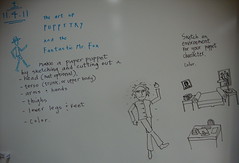Puppetry is used in almost all human societies both as an entertainment – in performance – and ceremonially in rituals and celebrations such as carnivals, says Wikipedia.[2]
Most puppetry involves storytelling. The impact of puppetry depends on the process of transformation of puppets, which has much in common with magic and with play.
Puppetry is a very ancient art form, thought to have originated about 30,000 years ago.[1]
Puppets have been used since the earliest times to animate and communicate the ideas and needs of human societies.[3] Some historians claim that they pre-date actors in theatre.
There is evidence that they were used in Egypt as early as 2000 BC when string-operated figures of wood were manipulated to perform the action of kneading bread. Wire controlled, articulated puppets made of clay and ivory have also been found in Egyptian tombs. Hieroglyphs also describe "walking statues" being used in Ancient Egyptian religious dramas.[1]
Although there are few remaining examples of puppets from ancient Greece, historical literature shows the existence of puppetry. The Greek word usually translated as "puppets" is "neurospasta", from "nervus", meaning either sinew, tendon, muscle, string, or wire, which literally means "string-pulling" and "span", to pull. Aristotle referred to pulling strings to control heads, hands and eyes, shoulders and legs.[15] Plato's work also contains references to puppetry. The Iliad and the Odyssey were presented using puppetry.
India has a great tradition of puppetry. In the great Indian epic Mahabharata there are references to puppets. The Rajasthani Puppet from India is notable and there are many Indian ventriloquists and puppeteers. The first Indian ventriloquist, Professor Y.K. Padhye, introduced this form of puppetry to India in the 1920s and his son, Ramdas Padhye, subsequently popularised ventriloquism and puppetry.
Indonesia has a strong tradition of puppetry. In Java, wayang kulit, an elaborate form of shadow puppetry is very popular. Javanese rod puppets have a long history and are used to tell fables from Javanese history.
Italy is considered by many to be the early home of the marionette due to the influence of Roman puppetry. Xenophon and Plutarch refer to them.[17] The Christian church used marionettes to perform morality plays.[17] It is believed that the word marionette originates from the little figures of the Virgin Mary, hence the word "marionette" or "Mary doll.[18] Comedy was introduced to the plays as time went by, and ultimately led to a church edict banning puppetry. Puppeteers responded by setting up stages outside cathedrals and became even more ribald and slapstick. Out of this grew the Italian comedy called Commedia dell'arte. Puppets were used at times in this form of theatre and sometimes Shakespeare's plays were performed using marionettes instead of actors.[19]
British Puppet theatre (Punch and Judy style), c. 1770
The traditional British Punch and Judy puppetry traces its roots to the 16th century to the Italian commedia dell'arte.[21] The character of "Punch" derives from the character Pulcinella, which was Anglicized to Punchinello. He is a manifestation of the Lord of Misrule and Trickster, figures of deep-rooted mythologies. Punch's wife was originally "Joan", but later became "Judy". In the late 18th and early 19th centuries, the familiar Punch and Judy puppet show which existed in Britain was performed in an easily-transportable booth.
Activity
Make a paper puppet and its environment.
Design, cut out, color and paste . . .
- head
- torso
- arms and hands
- thighs
- lower legs and feet
- environment may be sketched on the page as a base for the project.
- additional articulacy of your puppet may earn up to 10 additional points.
Friday, November 4, 2011
Subscribe to:
Post Comments (Atom)





No comments:
Post a Comment